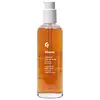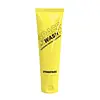What's inside
What's inside
 Key Ingredients
Key Ingredients

 Benefits
Benefits

 Concerns
Concerns

 Ingredients Side-by-side
Ingredients Side-by-side

Water
Skin ConditioningDecyl Glucoside
CleansingCocamidopropyl Betaine
CleansingChamomilla Recutita Flower Water
MaskingSodium Lauroyl Sarcosinate
CleansingGlycerin
HumectantSodium Lauroyl Lactylate
EmulsifyingNiacinamide
SmoothingVitis Vinifera Juice Extract
AntioxidantLactic Acid
BufferingSorbitol
HumectantVitis Vinifera Fruit Extract
Skin ConditioningSaccharomyces Ferment
Skin ConditioningPassiflora Incarnata Fruit Extract
Skin ConditioningCalendula Officinalis Flower Extract
MaskingMalic Acid
BufferingArginine
MaskingTocopherol
AntioxidantPropanediol
SolventSodium Laurate
CleansingEthylhexylglycerin
Skin ConditioningCitric Acid
BufferingSodium Hydroxide
BufferingPentylene Glycol
Skin ConditioningCaprylyl Glycol
EmollientPotassium Sorbate
PreservativeSodium Benzoate
MaskingWater, Decyl Glucoside, Cocamidopropyl Betaine, Chamomilla Recutita Flower Water, Sodium Lauroyl Sarcosinate, Glycerin, Sodium Lauroyl Lactylate, Niacinamide, Vitis Vinifera Juice Extract, Lactic Acid, Sorbitol, Vitis Vinifera Fruit Extract, Saccharomyces Ferment, Passiflora Incarnata Fruit Extract, Calendula Officinalis Flower Extract, Malic Acid, Arginine, Tocopherol, Propanediol, Sodium Laurate, Ethylhexylglycerin, Citric Acid, Sodium Hydroxide, Pentylene Glycol, Caprylyl Glycol, Potassium Sorbate, Sodium Benzoate
Water
Skin ConditioningLauric Acid
CleansingCocamidopropyl Betaine
CleansingDecyl Glucoside
CleansingSalix Alba Bark Extract
AstringentDisodium Cocoamphodiacetate
CleansingSodium Chloride
MaskingPotassium Hydroxide
BufferingEthylhexylglycerin
Skin ConditioningAcrylates/Steareth-20 Methacrylate Crosspolymer
Glycerin
HumectantGlyceryl Oleate
EmollientCoco-Glucoside
CleansingCitric Acid
BufferingPotassium Carbonate
BufferingChamomilla Recutita Flower Extract
MaskingMyristic Acid
CleansingCapric Acid
CleansingSodium Benzoate
MaskingCalendula Officinalis Flower Extract
MaskingOcimum Sanctum Leaf Extract
Skin ConditioningSalvia Officinalis Leaf Extract
CleansingPhenoxyethanol
PreservativeTocopherol
AntioxidantPotassium Sorbate
PreservativeHydrogenated Palm Glycerides Citrate
EmollientWater, Lauric Acid, Cocamidopropyl Betaine, Decyl Glucoside, Salix Alba Bark Extract, Disodium Cocoamphodiacetate, Sodium Chloride, Potassium Hydroxide, Ethylhexylglycerin, Acrylates/Steareth-20 Methacrylate Crosspolymer, Glycerin, Glyceryl Oleate, Coco-Glucoside, Citric Acid, Potassium Carbonate, Chamomilla Recutita Flower Extract, Myristic Acid, Capric Acid, Sodium Benzoate, Calendula Officinalis Flower Extract, Ocimum Sanctum Leaf Extract, Salvia Officinalis Leaf Extract, Phenoxyethanol, Tocopherol, Potassium Sorbate, Hydrogenated Palm Glycerides Citrate
 Reviews
Reviews

Ingredients Explained
These ingredients are found in both products.
Ingredients higher up in an ingredient list are typically present in a larger amount.
Calendula Officinalis Flower Extract comes from the common Marigold plant. This ingredient is a skin conditioner.
Marigolds contain flavonoids. Flavonoids are a group of substances found naturally in plants. They possess antioxidant and inflammation properties.
This ingredient soothes skin inflammation by inhibiting inhibiting a part of the inflammation process.
Marigolds have been used in traditional medicine throughout Asia and Europe.
Learn more about Calendula Officinalis Flower ExtractCitric Acid is an alpha hydroxy acid (AHA) naturally found in citrus fruits like oranges, lemons, and limes.
Like other AHAs, citric acid can exfoliate skin by breaking down the bonds that hold dead skin cells together. This helps reveal smoother and brighter skin underneath.
However, this exfoliating effect only happens at high concentrations (20%) which can be hard to find in cosmetic products.
Due to this, citric acid is usually included in small amounts as a pH adjuster. This helps keep products slightly more acidic and compatible with skin's natural pH.
In skincare formulas, citric acid can:
While it can provide some skin benefits, research shows lactic acid and glycolic acid are generally more effective and less irritating exfoliants.
Most citric acid used in skincare today is made by fermenting sugars (usually from molasses). This synthetic version is identical to the natural citrus form but easier to stabilize and use in formulations.
Read more about some other popular AHA's here:
Learn more about Citric AcidCocamidopropyl Betaine is a fatty acid created by mixing similar compounds in coconut oil and dimethylaminopropylamine, a compound with two amino groups.
This ingredient is a surfactant and cleanser. It helps gather the dirt, pollutants, and other impurities in your skin to be washed away. It also helps thicken a product and make the texture more creamy.
Being created from coconut oil means Cocamidopropyl Betaine is hydrating for the skin.
While Cocamidopropyl Betaine was believed to be an allergen, a study from 2012 disproved this. It found two compounds in unpure Cocamidopropyl Betaine to be the irritants: aminoamide and 3-dimethylaminopropylamine. High-grade and pure Cocamidopropyl Betaine did not induce allergic reactions during this study.
Learn more about Cocamidopropyl BetaineDecyl Glucoside is a glucose-based surfactant and emulsion stabilizer. It is created by reacting glucose with the fatty acids from plants.
Surfactants help clean the skin by trapping oil, sebum, and dirt to be washed away. As an emulsion stabilizer, it stabilizes the ingredients in a product by preventing them from separating.
This ingredient is biodegradable and non-toxic. This ingredient is commonly found in baby shampoos.
Decyl Glucoside is sometimes used to stabilize the UV filter Tinosorb.
Learn more about Decyl GlucosideEthylhexylglycerin (we can't pronounce this either) is commonly used as a preservative and skin softener. It is derived from glyceryl.
You might see Ethylhexylglycerin often paired with other preservatives such as phenoxyethanol. Ethylhexylglycerin has been found to increase the effectiveness of these other preservatives.
Glycerin is already naturally found in your skin. It helps moisturize and protect your skin.
A study from 2016 found glycerin to be more effective as a humectant than AHAs and hyaluronic acid.
As a humectant, it helps the skin stay hydrated by pulling moisture to your skin. The low molecular weight of glycerin allows it to pull moisture into the deeper layers of your skin.
Hydrated skin improves your skin barrier; Your skin barrier helps protect against irritants and bacteria.
Glycerin has also been found to have antimicrobial and antiviral properties. Due to these properties, glycerin is often used in wound and burn treatments.
In cosmetics, glycerin is usually derived from plants such as soybean or palm. However, it can also be sourced from animals, such as tallow or animal fat.
This ingredient is organic, colorless, odorless, and non-toxic.
Glycerin is the name for this ingredient in American English. British English uses Glycerol/Glycerine.
Learn more about GlycerinPotassium Sorbate is a preservative used to prevent yeast and mold in products. It is commonly found in both cosmetic and food products.
This ingredient comes from potassium salt derived from sorbic acid. Sorbic acid is a natural antibiotic and effective against fungus.
Both potassium sorbate and sorbic acid can be found in baked goods, cheeses, dried meats, dried fruit, ice cream, pickles, wine, yogurt, and more.
You'll often find this ingredient used with other preservatives.
Learn more about Potassium SorbateSodium Benzoate is a preservative. It's used in both cosmetic and food products to inhibit the growth of mold and bacteria. It is typically produced synthetically.
Both the US FDA and EU Health Committee have approved the use of sodium benzoate. In the US, levels of 0.1% (of the total product) are allowed.
Sodium benzoate works as a preservative by inhibiting the growth of bacteria inside of cells. It prevents the cell from fermenting a type of sugar using an enzyme called phosphofructokinase.
It is the salt of benzoic acid. Foods containing sodium benzoate include soda, salad dressings, condiments, fruit juices, wines, and snack foods.
Studies for using ascorbic acid and sodium benzoate in cosmetics are lacking, especially in skincare routines with multiple steps.
We always recommend speaking with a professional, such as a dermatologist, if you have any concerns.
Learn more about Sodium BenzoateTocopherol (also known as Vitamin E) is a common antioxidant used to help protect the skin from free-radicals and strengthen the skin barrier. It's also fat soluble - this means our skin is great at absorbing it.
Vitamin E also helps keep your natural skin lipids healthy. Your lipid skin barrier naturally consists of lipids, ceramides, and fatty acids. Vitamin E offers extra protection for your skin’s lipid barrier, keeping your skin healthy and nourished.
Another benefit is a bit of UV protection. Vitamin E helps reduce the damage caused by UVB rays. (It should not replace your sunscreen). Combining it with Vitamin C can decrease sunburned cells and hyperpigmentation after UV exposure.
You might have noticed Vitamin E + C often paired together. This is because it is great at stabilizing Vitamin C. Using the two together helps increase the effectiveness of both ingredients.
There are often claims that Vitamin E can reduce/prevent scarring, but these claims haven't been confirmed by scientific research.
Learn more about TocopherolWater. It's the most common cosmetic ingredient of all. You'll usually see it at the top of ingredient lists, meaning that it makes up the largest part of the product.
So why is it so popular? Water most often acts as a solvent - this means that it helps dissolve other ingredients into the formulation.
You'll also recognize water as that liquid we all need to stay alive. If you see this, drink a glass of water. Stay hydrated!
Learn more about Water